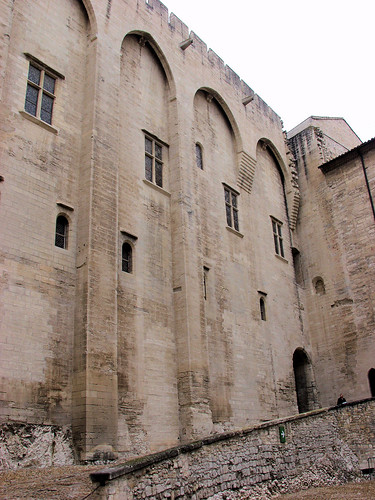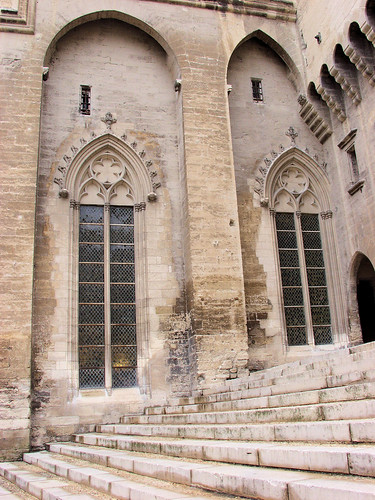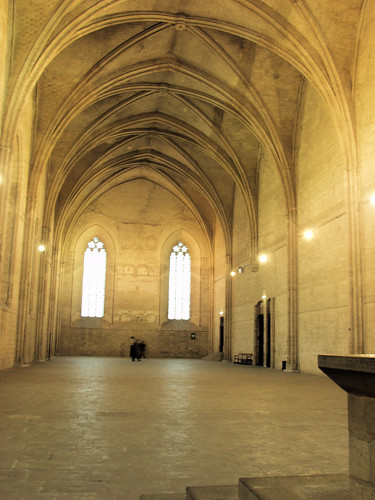
It is big, really big, and heavy, like the oppressive weight of the Catholic Church, although I can’t help wondering if it would have proved quite such a tourist attraction had not Pope Clement VI added those two curvy, sexy frivolous little mini-towers on the front, even though they are architecturally rather silly when lined up with the rest of the building.

In fact there are two palaces, very distinct in their architecture – that built by Pope Benedict XII (between 1335 and 1346 – finished after his death) was truly “medieval” in feel. He began with what is known as the Pope’s Tower, which is little more than a straight Norman keep, and even in the main quadrangle of this Old Palace, which does feel more like a residence, the windows are small and utilitarian, putting light where it is needed, with no reference to the overall balance of a room or how it meets the eye. Grand ceilings – of wood, so few have survived – were the only real architectural feature.

Then, it feels, the Renaissance arrived – well it must have been around already in some respects, but the second palace (built 1342-1351), that of Pope Clement VI, who was bred to be a fine Renaissance prince, and it looks like it. This palace is joined at rather odd angles to the first (both are oddly shaped in places to deal with the protruberances of the underlying rock).

The addition created the Courtyard of Honour, the grand gathering place from which the great and good could watch a new Pope bless them from some nicely fancy windows before proceeding into the Grand Chapel (above) – 52m long and 20m high, with gorgeous ribbed vaulting, for the culmination of his enthronement. (The whole ceremony took nine hours.)
Underneath was the equally large in fotprint but lower Great Audience Hall, where much of the business of the papacy was conducted.
The architect Jean de Louvres had some prety considerable challenges, as is evident from outside, for there is a grand flying buttress that helps to hold the middle of the chapel up, but it has to bridge over an ancient road cut through the rock here, and the foundations twist and turn to deal with the rising rock.
There’s not, it has to be said, a great deal of atmosphere. The two chambers that give most sense of what it must have been like to be here at Avignon’s heyday are the papal bedrooms, where the wall decorations were heavily restored in the 19th and 20th century.
The older is the Pope’s Chamber, at the top of that great first tower, which has a build forest theme, the forest of vegetation packed with birds, squirrels and other small life. There is, however, no perspective – it is like wallpaper.
You then walk through to what is known as “the stag room”, which was Pope Clement VI’s study, where he also often slept. The painting here has sophisticated perspective, and a distinctly princely theme – hunting and fishing.
I tried hard to feel the atmosphere in the parement chamber, where Queen Joanna of Naples (who many thought had recently had her rather barbarous Hungarian husband murdered) received the Golden Rose, given on a certain Sunday to the most distinguished personage then at the Papal Court. Unfortunately the builders were in and had the angle-grinders going, which made atmosphere rather hard to sense.
My guide, other than the rather dry handbook you get at the site, which seems merely to summarise the audioguide, was Marzieh Gail’s 1966 Avignon in Flower: 1309-1403 which intertwines tales of the pope’s and Petrarch in a lively enough popular history fashion, if marked by the casual misogyny typical of this era. (He’s not a fan of Queen Joanna of Naples, and tries hard to convict her.)
He says of this rose ceremony:
Urban’s cardinals “claimed that no Queen had ever received such a flattering distinction before. They, to a man, were particularly critical because a Queen had been chosen for the honour when a King was available. (The King of Cyprus was indeed present – because he had been banished from his throne.)”

 About
About
3 Comments
Pingback: Avignon: Petite Palace and Calvet Museum - Philobiblon